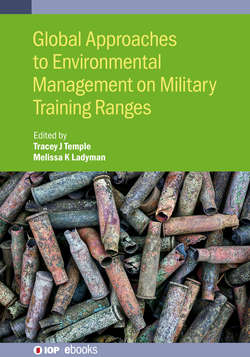Читать книгу Global Approaches to Environmental Management on Military Training Ranges - Tracey Temple - Страница 27
На сайте Литреса книга снята с продажи.
1.4.3 Transformation and reaction processes
ОглавлениеIn addition to the physical phenomena mentioned above, there are processes of a chemical or biochemical nature that affect the destination of contaminants transported in groundwater.
Generally the reactive processes are described via a measure of the attenuated transport (i.e. retardation) of a reactive contaminant species compared to the advective behaviour of groundwater [114]. The retardation in the ADRT equation can be a consequence of the processes that prevent the transfer of contaminant substances by immobilisation. Among the examples of chemical reactions there are:
Sorption: mainly involves an accumulation of the contaminant molecules on the pore surfaces through physical adsorption to surface and absorption into the body of the sorbent material.
Precipitation: consists in the fact that any excess dissolved substance is transformed into solid because its concentration exceeds the solubility of a particular component.
Filtration: is a physical process of retardation produced by the obstruction of porous spaces resulting from the accumulation of solid particles, although it may also be due to precipitation and the accumulation of dissolved matter.
Ion exchange: consists of a process in which the ions are sorbed in solutions that accumulate on discrete surface areas with opposite charge of the soil particles.
Volatilisation: occurs when the intermolecular forces, holding together molecules in the liquid and solid state, when transferring from solid to liquid, liquid to vapour, or solid to vapour, are overcome by absorbing energy, usually thermal energy from the environment. Volatility depends upon the temperature and the chemical composition of the compound. At any particular temperature, a volatile liquid or solid has a characteristic vapour pressure that is the equilibrium partial pressure in the atmosphere or air space surrounding the compound.
It should be noted that the immobilised contaminants are not transformed and that these processes are reversible. Then, the delayed contaminants can return to their soluble state after a prolonged period of time, producing a long trail of contamination. The process of retardation in the transport of a contaminant is caused mainly by the adsorption processes.
Adsorption refers to the attachment of a chemical to the surface of a soil particle. In soil, this process is exhibited when a molecule of gas, free liquid, or contaminants dissolved in water is attached to the surface of an individual soil particle (often in the form of organic carbon). This surface attachment can be physical (very weak, caused by van der Waals forces), chemical (much stronger, which often requires significant effort to separate) and exchange, i.e. characterised by electrical attraction between the sorbate and the surface (exemplified by ion-exchange processes). Since sorption is primarily a surface phenomenon, its activity is a direct function of the surface area of the solid as well as the electrical forces active on that surface. When a pollutant is adsorbed onto soil, it can be released only when the equilibrium between it and the passing fluid (water or air) is disrupted [109, 115].
The process is complex, for which a delay factor is defined that slows down the transport velocity of the contaminant according to the following expression (1.9):
Vc=VwRd(1.9)
where Vc = contaminant velocity, [L/T]; Vw = water velocity, [L/T]; Rd = retardation factor.
The retardation factor describes the apparent discrepancy between the actual migration rate of aquifer water and that of a dissolved organic chemical (somewhat slower). The difference in travel rates is the result of sorption of the chemical onto the aquifer matrix and release into water by the concentration gradient and time of contact. A general equation used for gross estimation of the retardation factor Rd is (1.10):
Rd=1+ρnKd(1.10)
where Rd = retardation factor, ρ = bulk density of soil, [M/L3]; Kd = partitioning coefficient, [L3/M]; n = effective porosity.
The partitioning coefficient Kd can be calculated by (1.11):
Kd=Kocfoc(1.11)
where Koc [L3/M] is the organic carbon equilibrium coefficient and foc is the fraction of organic carbon.
